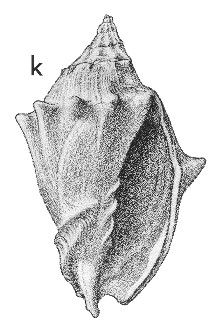
Revised descriptions of New Zealand Cenozoic Mollusca from Beu and Maxwell (1990)

 | Revised descriptions of New Zealand Cenozoic Mollusca from Beu and Maxwell (1990) | 
|
  (Pl. 6k): GS11148, J40/f8858, South Branch, Waihao River near Waihao Downs, Bortonian (GNS) |
Beu & Maxwell (1990): Chapter 7; p. 109; pl. 6 k.
Synonymy: Galeodes biconica Suter 1917, p. 18-19; Fulgoraria (Alcithoe) biconica Suter 1917, p. 39-40; Mauia biconica; Mauia curvispina Marwick 1926a, p. 273; Mauira curvispina
Classification: Volutidae: Zidoninae
Description: Size moderate for family (height 70-80 mm), broadly biconic, spire 0.25-0.4 total height. Protoconch mamillate, of about 2 whorls with apical spike. Teleoconch whorls sharply angled, but angulation on spire whorls of most shells obscured by sutural ramp of succeeding whorl. Sutural ramp flat or slightly convex; sides of last whorl straight or gently convex, contracted gradually. Axial sculpture on early whorls of narrow costae with sharp tubercles at angulation, later whorls with prominent peripheral tubercles that are scarcely prolonged abapically and vary in length and curvature; 8 or 9 on last whorl. Spiral sculpture of numerous very fine threads preserved on only a few shells. Aperture capacious, columella almost straight with 4 prominent subequal plaits; inner lip thinly callused, outer lip probably slightly reflected. Siphonal notch deep, oblique; fasciole prominent, raised, ridge-margined.
Comparison: Apart from its larger size, the type of Mauira curvispina differs from that of M. biconica (which is not adult) only in having a slightly more convex last whorl and longer, more strongly curved spines, differences that are not in themselves sufficient to discriminate species in the Volutidae. The relationship of M. biconica to other nominal Bortonian species of Mauira is less clear, however. M. waihaoensis (also from Waihao Downs) was based on a shell with a relatively tall spire in which the peripheral angulation is clear of the succeeding whorl, and is very similar, if not identical to M. angusta (Kakahu). Future work will probably show that M. angusta and M. waihaoensis are additional synonyms of M. biconica. M. maoriana (also from Kakahu, and the type species of Mauira) seems to be a distinct, rather bizarre species in which the tubercles are in a more anterior position so that on the last whorl they emerge from the aperture.
Mauira is an endemic genus which is first recorded from the "Matau" faunule of Castle Hill Shaft, Kaitangata (Porangan?) and is represented in many shallow-water Bortonian faunules, but then disappears from the fossil record, only to apparently reappear in the Altonian. However, the Altonian and younger records are clearly the result of convergent evolution, and are now referred to Alcithoe.
Distribution: Bortonian, Waihao Greensand, Kakahu (type of G. biconica); "Waihao River", probably Waihao Downs (type of F. biconica); Waihao Downs (type of M. curvispina); Hampden Formation, Hampden Beach; Pareora River. Moderately common to uncommon at listed localities.
Cite this publication as: "A.G. Beu and J.I. Raine (2009). Revised
descriptions of New Zealand Cenozoic Mollusca from Beu and Maxwell (1990). GNS
Science miscellaneous series no. 27."
© GNS Science, 2009
ISBN
978-0-478-19705-1
ISSN 1177-2441
(Included with a PDF facsimile file
copy of New Zealand Geological Survey Paleontological Bulletin 58 in CD version
from: Publications Officer, GNS Science, P.O. Box 30368 Lower Hutt, New
Zealand)